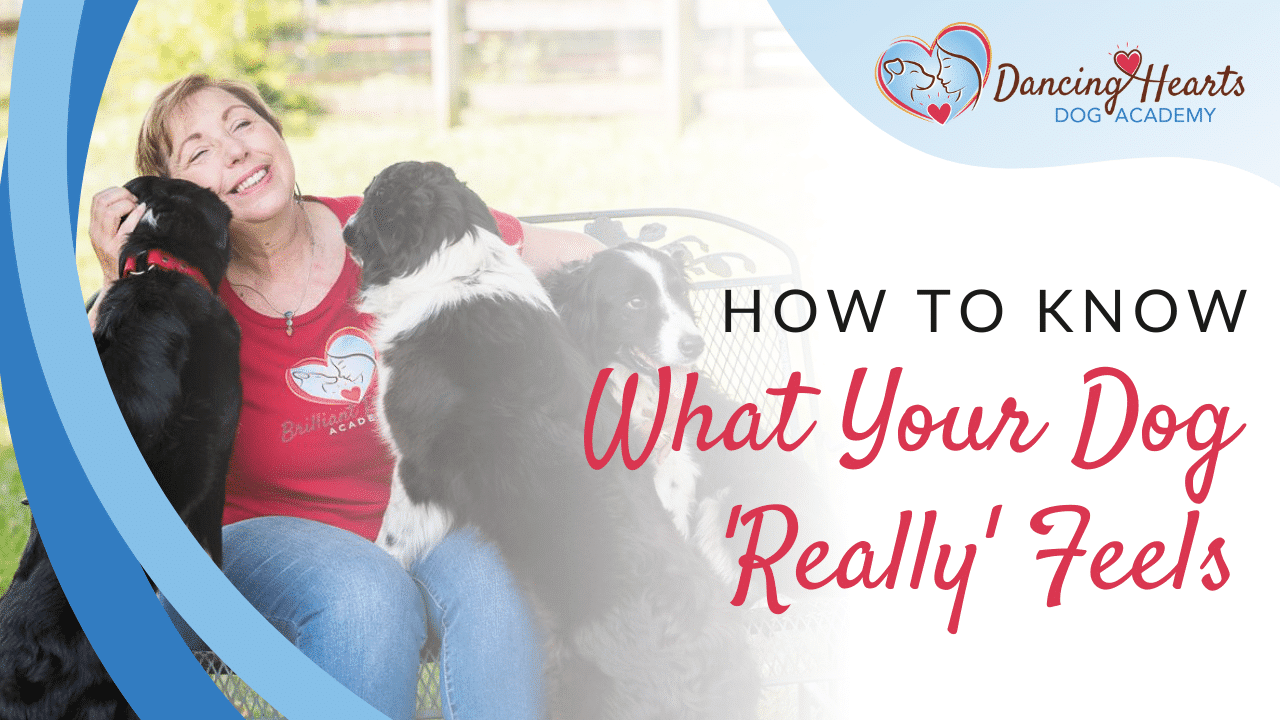Can you tell how your dog is feeling?
Understanding how your dog feels takes time. It’s easy to misinterpret your dog’s emotions and feelings because they don’t show their feelings in the same way as humans.
As a dog mom, you want your dog to be happy. Nobody wants their dog to feel sad, frightened, over-aroused, or distressed.
So, how can you know what your dog is really feeling?
Keep reading to find out!
Is your dog feeling stressed?
Obviously, we can’t ask our dogs how they feel and expect a straight answer. We have to learn to listen in other ways.
Identifying our dog’s stress levels can be quite difficult. Sometimes it’s easy to overlook just how much our dogs are affected by stressful situations. Like us, dogs can only handle so much stress until their stress bucket overflows.
To help you picture this better, think of your stress bucket like a transparent plastic cup. You and your dog both have one of these cups and every time you experience a stressful situation together, stress levels rise. Cortisol levels increase whenever we feel stressed, and the same thing happens to your dog. The cup fills up, and the stress levels rise and rise until it bubbles over, and all hell breaks loose.
Studies have shown that it takes from 36 hours up to eight weeks for cortisol to flush out of your system (and your dog’s system). That’s a long time to deal with such a high level of stress.
You and your dog need a stress RESET!
You cannot keep functioning properly when your stress levels are sky-high. Your dog is the same, they get stressed too and if you’re stressed, your dog is right there next to you. You might be able to stammer along in a constant state of stress but eventually, you will burn out. You will stop enjoying life and you and your dog will struggle to find happiness together because you’re both so overwhelmed and stressed.
This is why I recommend you and your dog make the conscious effort to have a stress reset. It’s time to turn back the clock, lower your stress levels, and start enjoying life together.
Before you list all the reasons why you can’t do a stress reset, don’t. The friction you’re experiencing right now is coming from your brain and your brain is essentially tricking you to stay within your comfort zone. It doesn’t matter if your comfort zone is the worst place on earth, it’s familiar and your brain automatically assumes that because it’s familiar, it must be good.
Therefore, whenever you try to step out of your comfort zone and make a change like this, you’ll feel some resistance. But, if you want to start living a stress-free life with your dog, you need to be resilient, fight back, and allow yourself to escape the current state of stress and turmoil you and your dog are stuck in.
VIP Members from BPA Share their Experience
My Brilliant Partners Academy is a membership coaching program with a strong community element. It’s where I help dog moms build a trusting, harmonious and deeply connected relationship with their dogs through my holistic, heart-to-heart partnership lifestyle framework.
My framework teaches dog moms to approach their relationship with their dog through new eyes, to see their dog’s perspective, and to turn life into a dance, where both will thrive, as individuals, and as partners. Some of my VIP members shared their wonderful experiences and I think it’s relevant to this topic of understanding how our dogs feel and learning to build a loving partnership with them that is not spearheaded by stress, but embodies the safe, happy, and calm lifestyle that we all want to have with our dogs.
So, here is a quote from one of our incredible members of the group:
“When we adopted Murphy and six weeks later, he started OCD behavior which then turned into resource guarding, shortly after that, Bear started to react to fast-moving cars and bikes. Before we knew it, we had two dogs fighting all the time.”
At this stage, Murphy, who is deaf and had a troubled history before joining the family, is finding things very difficult. He is almost inconsolable and lashed out by tearing down curtains and causing a giant mess. This then impacted their other dog Baer, who became fearful and reactive of fast-moving vehicles. It was clear that both of the dogs’ stress levels had maxed out and they needed a stress reset.
“I had to keep them separate all the time. I couldn’t go for walks and driving them to quiet places didn’t even work anymore. I felt trapped and I was ready to rehome Murphy to get our lives back. We had been training in private sessions and reactive dog classes and in March of 2018, I saw a video of Kathy’s BPA, and after watching it, I thought to myself… I have tried everything, what do I have to lose?”
“Today, 10 months later, I can take Bear and Mary in the car, out for walks and all three dogs can be inside the house together with supervision. I no longer try to fix Murphy. We have a great partnership and he has turned into a real snuggle bug. We’re going to take it day by day so he can live his life to the fullest. It’s been a great learning experience for all of us and BPA is such a great support group, I am forever grateful.”
This BPA member figured out how to stop her and her dog’s stress levels from overflowing. She took the teachings on board and gave it everything she had and thankfully, all of her hard work has really paid off. It’s not perfect, but they’re happy and they’re thriving.
Many members of BPA have experienced fast turnarounds like this because the humans have committed themselves to be brilliant partners. They stop trying to fix their dogs and they’ve taken time to understand and learn how to communicate and LIVE with their dogs.
How to know what your dog is feeling
Not sure about your dog’s behavior or how to proceed?
Sadly, many times when our dog appears to be excited and happy, they’re actually not. Instead, they’re frantic. This tends to happen more frequently with dogs who have been trained to have a transactional relationship with us. They are frantic because they are trying to find what will work to help get them what they want (play, treats, attention, etc.).
If your relationship with your dog is mostly based on transactions, it will be very hard for you and your dog to live peacefully together because you’re missing a heart connection. You need to work on building a partnership foundation that will help you and your dog better understand each other.
A heart connection doesn’t need any transactions to keep it afloat and it’s this type of connection that will help you build a brilliant partnership with your dog.
It’s important to get in the habit of really listening to your dog. Consider the big picture and remember that if you don’t feel safe, calm, and happy, then your dog won’t feel those things either. Similarly, if you do feel safe, calm, and happy, then your dog is very likely to feel the same way because our dogs often mirror us and our emotions.
An in-active dog does not mean your dog feels relaxed, so make sure that you don’t misinterpret this! Relaxation does not equal inactivity. The maximum recommended of high-arousal activity (which varies for every dog) is between 10% to 15% of your dog’s daily routine. That’s it!
If your dog is doing more than the recommended amount, cut it back! 50% of the day should be low or no-arousal activities such as just hanging about the house, cuddles on the couch, and so on.
The key to understanding how your dog is feeling is to listen to your dog and do everything you can to avoid the high-stress situations that you know will fill up both of your stress buckets!
If you’d like to work with me and learn how to create a partnership lifestyle for you and your dog, you can request an invitation to join us in the Brilliant Partners Academy when the doors open for the next enrolment!
You can listen to everything I talked about in this blog post over on my podcast – Enlightened By Dogs. It’s episode 115, which you can listen to here.






